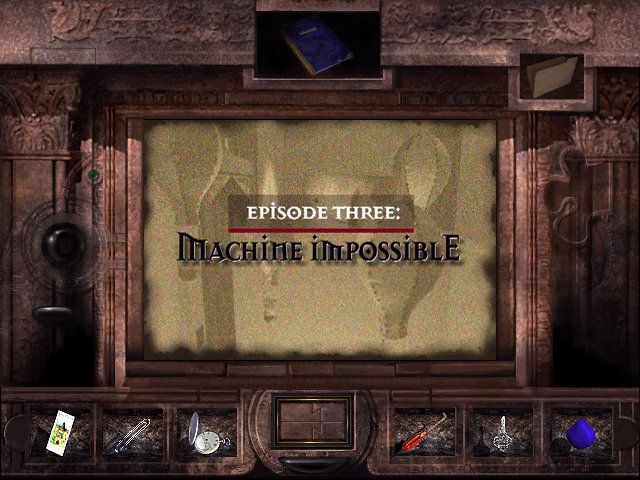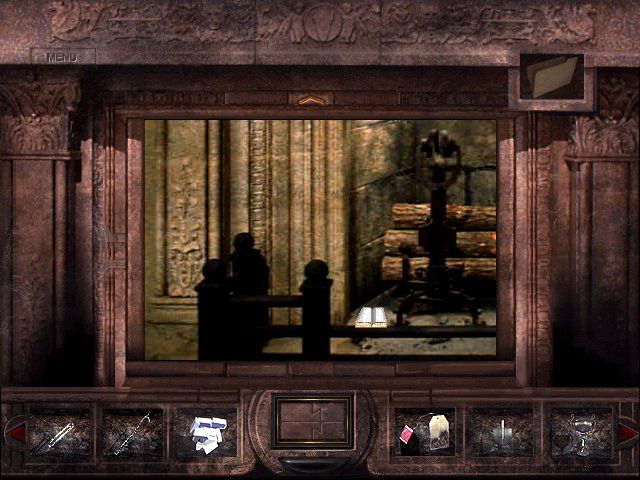Retro Replay Review
Gameplay
Temüjin delivers a distinctive first-person adventure experience that hinges on full-motion video (FMV) integration and 360-degree navigation. From the moment you find yourself in the Stevenson Museum lobby with no memory or identity, the game’s control scheme invites careful exploration. You can pan freely in any direction, examining exhibit cases, reading placards, and searching for clues. Movement is node-based, meaning you click to move between fixed positions, but the seamless panning keeps immersion high.
(HEY YOU!! We hope you enjoy! We try not to run ads. So basically, this is a very expensive hobby running this site. Please consider joining us for updates, forums, and more. Network w/ us to make some cash or friends while retro gaming, and you can win some free retro games for posting. Okay, carry on 👍)
Puzzle design in Temüjin revolves around the museum’s Mongolian exhibits and the mystical artifacts once buried with Genghis Khan. You’ll pick up objects, rotate and examine them, then combine or use them to solve context-sensitive puzzles. These range from deciphering ancient scripts to manipulating mechanical replicas of Mongolian siege engines. The puzzles require both attention to detail and historical curiosity, making progress feel earned rather than handed to you.
Interaction with NPCs is limited yet memorable. You cannot speak, so communication is achieved through context menus and item use. As museum staff and visitors wander the halls, you’ll experiment with giving or showing them certain artifacts—sometimes provoking helpful guidance, other times sinister consequences. Across seven episodic chapters, this blend of silent roleplay, environmental storytelling, and logic challenges keeps gameplay varied and engaging.
Graphics
Visually, Temüjin leans heavily on its live-action video sequences. The production values are characteristic of mid-90s FMV titles: set design and costuming are surprisingly detailed, while lighting occasionally casts deep shadows to heighten mystery. Close-ups of actors at exhibit windows feel authentic, and archival-style footage of Mongolian warriors adds historical gravitas.
The 360-degree panoramas are pre-rendered stills overlaid with video elements. Museum corridors, ornate display cases, and roped-off relics appear as high-resolution backdrops you can swivel around. Transitions between nodes fade smoothly, minimizing visual jank. Though modern gamers may notice the static nature of backgrounds, the period-accurate textures and careful staging maintain an immersive museum atmosphere.
Special effects tied to the artifacts’ dark power range from flickering lights to subtle distortions in the video playback. These touches are sparing but effective—just enough to hint that something unnatural stirs within the exhibits. The combination of live actors, practical set pieces, and occasional post-production glitches contributes to a uniquely uncanny aesthetic.
Story
At its core, Temüjin weaves historical fiction with supernatural intrigue. You learn that Genghis Khan’s real name was Temüjin, and after his death he was interred with powerful mystical artifacts. Those relics have slept for centuries until modern archaeologists unearthed them and placed them on display. The narrative premise—an amnesiac trapped in a museum where ancient evil lurks—is simple yet compelling.
Story beats unfold gradually through environmental clues, NPC reactions, and episodic video interludes. Each chapter highlights a different artifact, revealing fragments of its dark purpose and how it tests your wit and resolve. The museum setting doubles as a character: hallways become increasingly oppressive, lighting shifts to evoke dread, and distant echoes heighten tension.
While dialogue is minimal, the game excels at atmospheric storytelling. You’re never explicitly told the full legend at once; instead, you piece it together by reading exhibit labels, triggering archival footage, and solving puzzles tied to Mongolian lore. By the final episode, the rising stakes and layered narrative twists culminate in an ending that rewards careful observation and historical curiosity.
Overall Experience
Playing Temüjin is to step into a time capsule of mid-90s FMV adventures—an era when developers experimented boldly with video integration and puzzle-driven narratives. The game’s strengths lie in its immersive museum setting, historically flavored puzzles, and the eerie resurgence of an ancient evil. While the node-based movement may feel dated, it supports deliberate exploration and adds to the sense of being a silent observer in a grand exhibit.
Audio design, featuring ambient museum sounds, tympanic drips, and a subtle Mongolian-inspired musical score, complements the visuals perfectly. The deliberate pace means Temüjin isn’t for players seeking nonstop action; it thrives on quiet moments, close scrutiny of relics, and slow-burn tension. Fans of puzzle adventures, historical mysteries, and FMV nostalgia will find themselves drawn into its haunting halls.
Ultimately, Temüjin offers a memorable voyage through history and horror. It challenges you to think like an archaeologist, pay attention to detail, and confront the uncanny resurgence of Temüjin’s buried power. If you’re intrigued by museum-based puzzles, evocative storytelling, and full-motion video craftsmanship, this game remains a distinctive relic worth exploring.
 Retro Replay Retro Replay gaming reviews, news, emulation, geek stuff and more!
Retro Replay Retro Replay gaming reviews, news, emulation, geek stuff and more!









Reviews
There are no reviews yet.